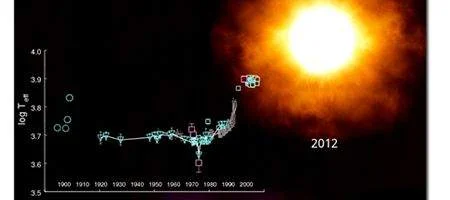A 30-year study of an extraordinary hypergiant star has revealed that it went through an extremely rare stage called the ‘Yellow Evolutionary Void.’

During this period, its temperature increased by about 3,000 degrees in less than three decades.
The discovery is an important step towards understanding hypergiants, the most luminous and massive stars of the galaxy, says the European team.
One of only 12 hypergiants known in our galaxy, HR 8752 is a quarter million times more luminous than the sun, and can be seen with ordinary binoculars in the Northern constellation of Cassiopeia.
The ‘Yellow Evolutionary Void’ is a unique stage in the short life of a hypergiant when its temperature and luminosity can quickly change. The team’s found that the atmospheres are very unstable during this period because outwardly-directed forces are equal to or sometimes even stronger than the force of gravity.
Because of this, hypergiants lose tremendous weight in this ‘forbidden zone’ – sometimes equivalent to the mass of the sun disappearing in a year.
“HR 8752 was around 1980 identical to the eruptive hypergiant Rho Cas of spectral type F, but then the temperature of HR 8752’s atmosphere rapidly increased by 3000 degrees and now shows the spectral properties of a hotter A-type star,” says Alex Lobel of the Royal Observatory of Belgium.
“We are baffled about the tremendous changes of HR 8752 in that period of time.”
Between 1900 and 1980, the atmospheric temperature of HR 8752 stayed almost constant around 5,000 degrees, but rose very rapidly to 8,000 degrees between 1985 and 2005. The team calculates that the stellar radius decreased from 750 to 400 times that of the sun.
In 1985, the team embarked on a long-term spectroscopic observing program when it found that the remarkable hypergiant was exactly at the border of the ‘Yellow Void’ and started to cross over.
They’ve discovered that the Void actually consists of two parts in which the atmosphere of the hypergiant is unstable. They result from ionization of large amounts of hydrogen and helium gas in the atmosphere, divided by a small zone around 8,000 degrees where it becomes more stable.
The fate of HR 8752 is currently unclear, says the team – but there are strong hints that these massive hypergiants may be destroyed in powerful supernova explosions, or quickly traverse the Void and transform into a hotter type of erratic star known as Luminous Blue Variables.






